Peru
Population: 28,303,000
Capital: Lima
Time Zone: GMT -5
Part of 2006 World Trip, arriving from Australia and going on to Bolivia.
The Inca trail, the Nazca lines, sand boarding; a whistle stop tour of Peru from deserts to lakes and beyond.
Use the navigation bar on the left or the map-links to select a place. Alternatively scroll down to see all the entries. Click on photos to enlarge. See all Peru photos here.
Lima
Whilst the last month of travelling had been quite easy going, my trip really turned into a holiday in Peru. I had pre-booked a three-week tour, which covered most of the popular sights and activities. This meant that I stayed in nice hotels and everything was organised for me. I really enjoyed the tour but it was more like a holiday than travelling and I don't think I would do another if I really want to see a country (that's the snobby backpacker in me) but would definitely do another if I just wanted some fun packed recreation.
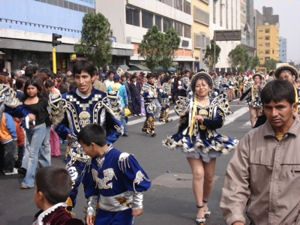
I had given myself four days in Lima to recover from any jet lag I might have and to look around before the tour started. I stayed in a hostel in the up-and-coming Barranco region of Lima. I was surprised at how modern and nice Lima was; I had studied the city in my A-Level geography class many years ago, and had the impression that it was dirty, full of slums and a bit dangerous.
The city itself has managed to separate itself from the slum area with the river and over the last few years there have been many improvements in the tourist police. This means the city is very nice, although I never felt any of Peru seemed dangerous. Peru (as well as the rest of South America I went to) is also very European, stemming from the long-standing Spanish rule and complete take over several hundred years ago, in much the same way the US shares much with the UK.
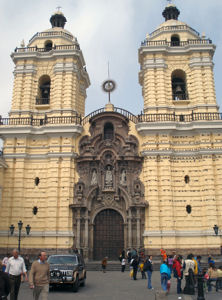 The first few days I spent wandering Barranco and Miraflores. The second day I was here coincided with the start of the World Cup and so I watched the first few group games in the mornings each of the following days. Whilst Peru is situated in the southern tropics the weather is surprisingly cold, and cloud covers the city for much of the year. I went to a museum one afternoon and learned a bit about the different ancient cultures of the country. I then spent a day in central Lima where there are some nice churches including the grand San Franciscan church and monastery with its catacombs where you can see the bones of hundreds of people filling large holes in the ground. If there is one thing the Peruvians like, it seems to be a parade, and being a weekend meant that there were parades everywhere with various levels of dressing up and music - these seem to occur spontaneously everywhere at any time in Peru - they are a fun loving people.
The first few days I spent wandering Barranco and Miraflores. The second day I was here coincided with the start of the World Cup and so I watched the first few group games in the mornings each of the following days. Whilst Peru is situated in the southern tropics the weather is surprisingly cold, and cloud covers the city for much of the year. I went to a museum one afternoon and learned a bit about the different ancient cultures of the country. I then spent a day in central Lima where there are some nice churches including the grand San Franciscan church and monastery with its catacombs where you can see the bones of hundreds of people filling large holes in the ground. If there is one thing the Peruvians like, it seems to be a parade, and being a weekend meant that there were parades everywhere with various levels of dressing up and music - these seem to occur spontaneously everywhere at any time in Peru - they are a fun loving people.
The next morning my trip began and I discovered just how nice the travelling would be. The picture shows the truck that transported us all over Peru. This had tables and suspension that smoothed the harshest of Andean roads. John, our driver, was great and knew all the good cafes and bars of each of the towns and Alan, the Tour Coordinator as he liked to be called, was also a good laugh and knew his stuff. Eleven of us started this trip although it was a combination of a number of options so this varied a little as we progressed. This group comprised of three Australian couples and then a little group of 5 of us who commandeered the bus tables and did most stuff together.
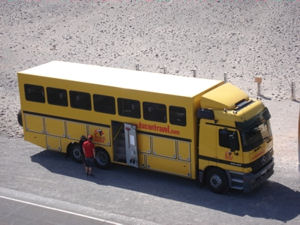
Pisco
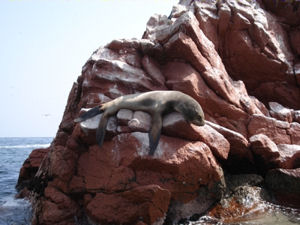
A few hours down the coast from Lima is the town of Pisco. While famous for the alcoholic drink Pisco Sour, made from a type of brandy, egg white and sugar, the main reason for coming here was to see the Ballestas Islands just out to sea. These are teaming with wild life including sea lions penguins and many other sea birds, although we came at a low season for the wildlife. We caught a speedboat out and around the rocks and en-route saw the mysterious Candelabra, which looks a bit like a cactus (or candle) and is etched into one of the mainland cliffs. The town of Pisco is nothing special, so it was no great loss we only had an afternoon here to look around.
Huacachina
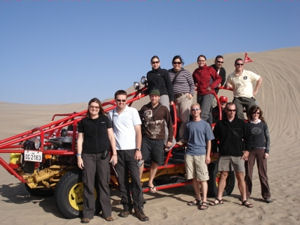
The next day was long but one of the best. As ever on the tour we were up early (often by 6) and headed over to the desert region of Huacachina. I had not realised that Peru had such a diversity of ecosystems, stretching from the Amazon rainforest over the mighty Andes and then into the desert regions the other side. Here, wind is rare and rain almost non-existent. While much of the region is simply a bare rocky landscape in Huacachina there are proper sand dunes. Once you have passed the first few dunes the area is totally silent and there is no sign of life. What does one do in such a serine environment? - But of course hire a V8 dune buggy and go on a roller coaster ride over the dunes. This was awesome fun and even better we would stop from time to time and sand board down the dunes. Initially we tried to board properly but this was hard so quickly we all ended up lying face down on the board and seeing how fast we could go - quite fast on the bigger, steeper, dunes it turns out.
Nazca
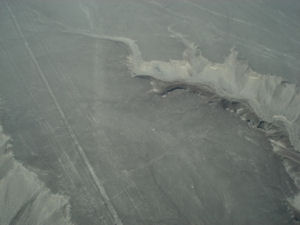
Later that day we headed over to the region of Nazca, in what is now a desert plateau. This is, of course, famous for the Nazca lines that are scattered around the area in the shapes of various things - the one shown here is a humming bird, its better to enlarge the picture to see it. Surprisingly the lines are little more than shallow scrapes in the sand, but since there is never any wind or rain in this region these have been preserved for hundreds of years. The best, and only, way to view the lines properly is from the air and there is a small airport dedicated to this. We took a 6 seater (including the pilot) plane up over the desert, which was great although incredibly bumpy.
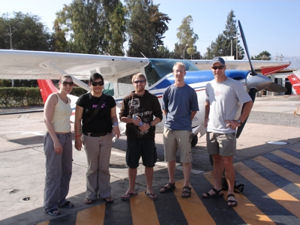 After so much excitement in one day we headed for the hotel and a quick dip in a surprisingly cold pool. Due to the early starts and hectic scheduling the evenings where usually short, although the 5 of us single people always managed to stay up after the couples - sometimes as late as 10:00.
The next morning we visited the Chauchilla graves. These date back to the Nazca people and were undisturbed for many hundreds of years. Unfortunately, with the arrival of the Spanish the value of gold increased and the locals took to grave robbing, leaving almost nothing of value and destroying many of the mummified bodies. Work is now being undertaken to preserve what is left and to look for unspoiled graves - the whole region is covered with tombs. They are doing a good job and it was nice to wander around and see some of the preserved artefacts.
That evening we headed over to the coastal bay of Puerto Inca. Here there are the ruins of an Inca port and one small hotel. We had a bit of a beach party here with some rather potent punch but there was nothing much else of note.
After so much excitement in one day we headed for the hotel and a quick dip in a surprisingly cold pool. Due to the early starts and hectic scheduling the evenings where usually short, although the 5 of us single people always managed to stay up after the couples - sometimes as late as 10:00.
The next morning we visited the Chauchilla graves. These date back to the Nazca people and were undisturbed for many hundreds of years. Unfortunately, with the arrival of the Spanish the value of gold increased and the locals took to grave robbing, leaving almost nothing of value and destroying many of the mummified bodies. Work is now being undertaken to preserve what is left and to look for unspoiled graves - the whole region is covered with tombs. They are doing a good job and it was nice to wander around and see some of the preserved artefacts.
That evening we headed over to the coastal bay of Puerto Inca. Here there are the ruins of an Inca port and one small hotel. We had a bit of a beach party here with some rather potent punch but there was nothing much else of note.
Arequipa
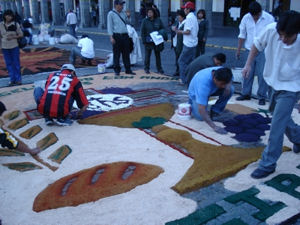 Arequipa is Peru's second largest city and is elevated in the foothills of the Andes, giving it a cool and pleasant climate. Whilst it has some heavy industry this is all situated away from the old town area, which is quite grand and, like all South American Spanish town, centred around a Plaza de Armas.
As ever, when we arrived there was some sort of festival going on, and people were making large Christian orientated mosaics from coloured sand.
Today England was playing Trinidad and Tobago and we though we might catch a re-run of the game at one of the bars surrounding the Plaza, but alas it wasn't shown. That evening we went to a tourist restaurant - twice the price and half the portion size of a local place with added Andean pipe player - and tried some Peruvian delicacies. I had the Alpaca (a type of wide Lama) but the main reason for going was to try the Guinea pig. We shared one, which was a good thing as it would not have been an overlay satisfying meal. It was of normal size and had just been baked so you had to dissect it to get to the small amount of meat.
That night we hit the town and Grant talked me into doing a Tequila suicide, something I won't be repeating in a hurry and didn't help the next day. Things were made easier with an excellent fry up in a little cafe of the main plaza. Ada and myself then went to see the main sights of Arequipa - the Santa Catalina Monastery, which was nice for a wander around, and Juanita (also known as "The Ice Maiden"), who was and Inca human sacrifice that had been frozen for hundreds of years and found on top of a nearby volcano.
Arequipa is Peru's second largest city and is elevated in the foothills of the Andes, giving it a cool and pleasant climate. Whilst it has some heavy industry this is all situated away from the old town area, which is quite grand and, like all South American Spanish town, centred around a Plaza de Armas.
As ever, when we arrived there was some sort of festival going on, and people were making large Christian orientated mosaics from coloured sand.
Today England was playing Trinidad and Tobago and we though we might catch a re-run of the game at one of the bars surrounding the Plaza, but alas it wasn't shown. That evening we went to a tourist restaurant - twice the price and half the portion size of a local place with added Andean pipe player - and tried some Peruvian delicacies. I had the Alpaca (a type of wide Lama) but the main reason for going was to try the Guinea pig. We shared one, which was a good thing as it would not have been an overlay satisfying meal. It was of normal size and had just been baked so you had to dissect it to get to the small amount of meat.
That night we hit the town and Grant talked me into doing a Tequila suicide, something I won't be repeating in a hurry and didn't help the next day. Things were made easier with an excellent fry up in a little cafe of the main plaza. Ada and myself then went to see the main sights of Arequipa - the Santa Catalina Monastery, which was nice for a wander around, and Juanita (also known as "The Ice Maiden"), who was and Inca human sacrifice that had been frozen for hundreds of years and found on top of a nearby volcano.
Colca
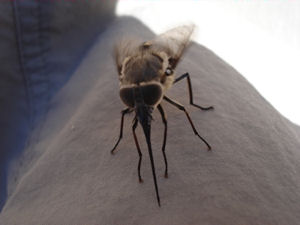 With another early start we headed over the small town of Chivay via a place called Colca canyon. To get here we had to drive over a pass with an elevation in excess of 5000m, this defined the start of the proper Andes and from here it would be cold for the next few weeks with our route rarely dropping below 3000m. En route we saw many Lamas, which are bred for wool and food, and had a little excitement when a tyre went on the Truck. Colca is partly famous for being the deepest canyon in the world. There is a certain amount of controversy over this depending on how depth is defined; however it was certainly deep and in the thermals set up by the shear valley Condors fly (the other thing Colca is known for). Things seem to be done on a grand scale here, and even the insects are of abnormal size - the one shown was nearly 10cm long and seemed quite attracted to humans although I think it was a pollen eater. We had a nice stroll around the Canyon top then headed for a hot spring for some relaxation.
With another early start we headed over the small town of Chivay via a place called Colca canyon. To get here we had to drive over a pass with an elevation in excess of 5000m, this defined the start of the proper Andes and from here it would be cold for the next few weeks with our route rarely dropping below 3000m. En route we saw many Lamas, which are bred for wool and food, and had a little excitement when a tyre went on the Truck. Colca is partly famous for being the deepest canyon in the world. There is a certain amount of controversy over this depending on how depth is defined; however it was certainly deep and in the thermals set up by the shear valley Condors fly (the other thing Colca is known for). Things seem to be done on a grand scale here, and even the insects are of abnormal size - the one shown was nearly 10cm long and seemed quite attracted to humans although I think it was a pollen eater. We had a nice stroll around the Canyon top then headed for a hot spring for some relaxation.
Chivay is situated in a valley high in the mountains and this desolate landscape is quite stunning. The photo nicely shows another thing the Incas are famed for - as we were now truly in Inca territory - the terracing of the hills. This is done to nearly every hillside and looks quite striking, while providing the much-needed flat land for agriculture not abundant in this terrain.
Cuzco
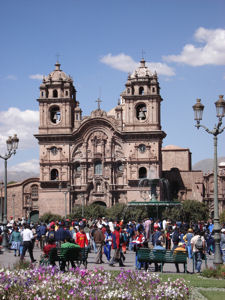 Central to any trip to Peru is Cuzco. The capital of the Inca Empire and gateway to the Inca trail, Cuzco is a thriving tourist centre. At this point our trip divided a little with everyone bar myself, Grant, Mark and Tanya disappearing for 2 days down into the rainforest while we stayed in Cuzco. With only a small number of us we were able to go to an excellent little cafe for dinner each evening and after a day sightseeing we hired mountain bikes and a guide and went for a cycle.
Central to any trip to Peru is Cuzco. The capital of the Inca Empire and gateway to the Inca trail, Cuzco is a thriving tourist centre. At this point our trip divided a little with everyone bar myself, Grant, Mark and Tanya disappearing for 2 days down into the rainforest while we stayed in Cuzco. With only a small number of us we were able to go to an excellent little cafe for dinner each evening and after a day sightseeing we hired mountain bikes and a guide and went for a cycle.
This was probably the best day I had in Peru; we were given excellent mountain bikes and taken over some great terrain whilst seeing some interesting sights. The ride started with a taxi up to around 4000m (we were meant to get a bus but they were on strike that morning). We then headed over some moderate trails (made more difficult by the altitude) to a place called Moray. This was an Inca agricultural testing centre where plants from the high Andes and low rainforest areas were grown in a controlled environment to see how they could be farmed elsewhere. This was done by making a large terraced pit, which gets more sheltered with increasing depth, and gives rise to quite a temperature range. Walking up and down the terraces was the only time I really felt the altitude and my heart rate in excess of 200 after the climb out of the pit. After lunch we headed down towards some salt terraces.
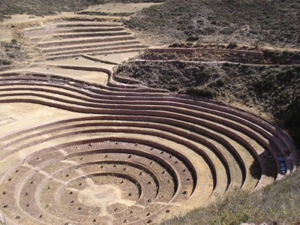
The way was several hours of down hill cycling with some quite technical single track as well as some really fast paths and even a BMX track, getting the adrenalin really going. En route we also passed through some small villages and got to try some local chicha as well as seeing the harvesting in full swing. The salt terraces channel hot-spring water into small pools, which are then isolated and allowed to evaporate. Due to the high salt content of the water the result is a bight white hillside where the locals get there salt - and if there were one essential ingredient in Peruvian cooking, it would have to be salt. After a little more cycling we got a bus back to Cuzco to meet up with the others along, with some new faces, to have our Inca trail briefing. The next day I was supposed to go with the other three to see some more sights in the sacred valley but unfortunately I was stuck down with a stomach bug that night and could barely move. Cuzco is the epicentre of diarrhoea bugs and many people seem to get hit by them.
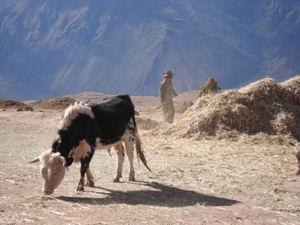
In an attempt to avoid such troubles in my spare few days in Lima I had tried to eat all the dodgy looking street food to up my tolerances - which after being fine everywhere in Asia, was quite good. However, it wasn't to be and so I spent a day watching the football - there are worse ways to spend a day I guess, and at least I got the worse of the bug out the way before the trail.
Inca Trail
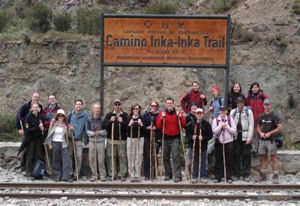
The classic start point of the Inca trail is Kilometre 88 (I think this is 88Km from Cuzco). On our way here we picked up some walking sticks and ponchos to help with the days ahead. The size of our group had swelled to 22, with a number of people just doing the trail. We really did the trail the easy way with porters carrying the tents, cooking equipment and some of our stuff, just leaving us with day bags. This made the walking fairly easy although there were some steep climbs and at that altitude I was glad to be just carrying my day bag.
The first day was quite easy although the light rain and lack of food the day before made it less enjoyable for me. We were treated to superb meals three times a day and even had cake for lunch. The porters carried chairs and a large dinning tent so we could even play cards in the evening.
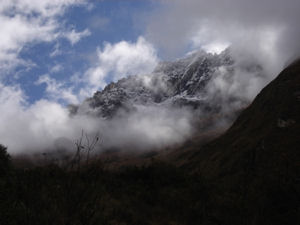 The second day was the tough one where we climbed over a kilometre in altitude up to 4200m. The pass is known as dead woman's pass - the Incas find shapes in every hill; occasionally it is possible to see where they are coming from but usually you need a lot of imagination or chicha.
The whole of the Inca trail is paved, and although the quality varies from place to place there is one constant - steps. Wherever the land is uneven (which is the entire trek) there are step. This is quite tiring on the knees going up but worse on the way down, and coming off the pass was almost as hard as going up. However, the sun came out when we reached our campsite and we had the afternoon to recover. Annoyingly my stomach bug, which seemed to have gone that morning, reappeared and I spent the much of the afternoon in the toilet block - it is possible to tell how much of a tourist trail it is from the high quality, although average cleanliness, of the toilet facilities.
The second day was the tough one where we climbed over a kilometre in altitude up to 4200m. The pass is known as dead woman's pass - the Incas find shapes in every hill; occasionally it is possible to see where they are coming from but usually you need a lot of imagination or chicha.
The whole of the Inca trail is paved, and although the quality varies from place to place there is one constant - steps. Wherever the land is uneven (which is the entire trek) there are step. This is quite tiring on the knees going up but worse on the way down, and coming off the pass was almost as hard as going up. However, the sun came out when we reached our campsite and we had the afternoon to recover. Annoyingly my stomach bug, which seemed to have gone that morning, reappeared and I spent the much of the afternoon in the toilet block - it is possible to tell how much of a tourist trail it is from the high quality, although average cleanliness, of the toilet facilities.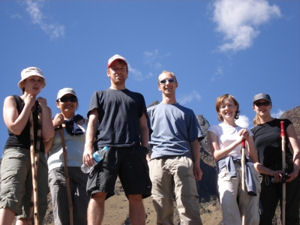 Day three was the best. Finally I was fully recovered, the sun was out and the walking was relatively flat for much of the day. We also walked through a variety of ecosystems from the high alpine grassland into the lower cloud forests and back to the mountain tops.
Day three was the best. Finally I was fully recovered, the sun was out and the walking was relatively flat for much of the day. We also walked through a variety of ecosystems from the high alpine grassland into the lower cloud forests and back to the mountain tops.
We were getting closer to Machu Picchu and this was apparent in the increasing number of Inca buildings and the occasional hillside terrace. It was quite a long day and we reached the campsite just before sunset after negotiating an incredibly long set of steps right from the mountain top down into the valley. This was our last night and the campsite also caters for those who want to do a one day Inca trail, meaning it was slightly more up market, with showers (if you could be bothered) and a bar (which we could be bother with). We said thank you to the porters by means of money and a traditional exchange of song - they sang an old Quechua song, we did a medley of Bohemian Rhapsody, Yellow Submarine and Fairy Tail of New York -
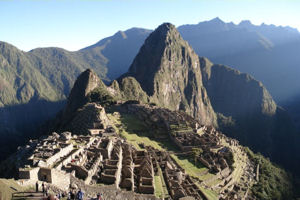 I think we probably got the better deal out of the exchange.
I think we probably got the better deal out of the exchange.The final day was an earlier start (3 a.m.) so we could watch the sunrise. The traditional place to watch the sunrise is from the sun temple, some way from Machu Picchu on the hills behind. After setting a fast pace we reached here well before the sun made it over the mountain tops and just as the sky was turning from purple to blue, bathing our first glimpses of the Inca citadel in a cool half light.
However, our guide was some way back and we heard another group say that it wasn't the sun temple as they continued walking, so we continued down the path to Machu Picchu itself. This was a better spot to watch sunrise anyway and everyone else joined us just as the first shafts of light came through the cleft in the mountains - we were here the day after the winter solstice, a very special time in the Inca calendar. After a stack of the usual photos we descended into the complex and had a tour of the main buildings.
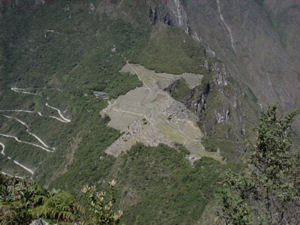
As the day progressed the area became more and more crowded with bus loads of people arrived every few minutes from Cuzco. This made me appreciate the time we had at sunrise when the whole area was quiet. After looking around the main sights a few of us climbed the steep little hill, Huayna Picchu, to get a better view of the whole sight. This was a steep walk and the exposure on top was pretty high, but the view was more than worth it. It is said that the shape of all Inca cities has meaning, and apparently Machu Picchu is in the shape of a condor sitting on a perch.
After this I went to see the Inca Bridge. The purpose of this I can't quite understand, since the rest of this unused stretch of trail is made from stone, clinging to a vertical cliff face - our only guess was below it was some kind of sacred place or burial site but I really have no idea. That afternoon we caught the train back to Cuzco and had a big night out to say farewell to those that were leaving us.
Lake Titicaca
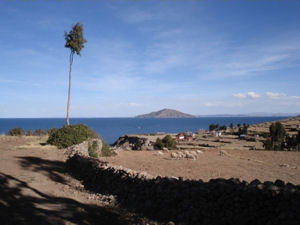
The following morning, bright and early as usual but a little worse for wear, we headed south to Lake Titicaca. At about 3800m this is one of the highest lakes in the world. That evening we stayed in Puno, on the lake's edge and caught up on some sleep. The following morning we got a boat out to Taquile Island. After a few hours looking around here we headed over to Amantani Island, a little further into the lake. Here we did the usual tourist thing and stayed with some local people. I was quite pessimistic about what this would entail but the tourist industry has been set up well on the island and I was quite impressed. The families are farmers, using tourism as extra income, and since the people in this part of the world still wear traditional clothing by choice it is not a forced affair. After a brief game of football with the locals (at nearly 4000m this get the heart rate up a little) we climbed the main hill of the island to watch the sunset.
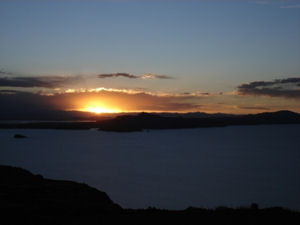
Alan and myself stayed with a woman who had two children and that evening she cooked a nice meal for us. Her younger son, Hilverd, then came to play. Since he spoke Spanish and Quechuan and I spoke neither the conversation was a bit limited but he seemed to enjoy playing with my camera taking photos of his toys. That evening we all dressed up in local clothing and went to a dance. This happens every night for the tourists and was good fun although you could tell the locals were a little bored with it.
The following day we travelled back to the mainland via Islas Flotantes; these are artificial islands made from reeds. This is very famous but you can only visit the tourist bit and once it has been see, that's enough.
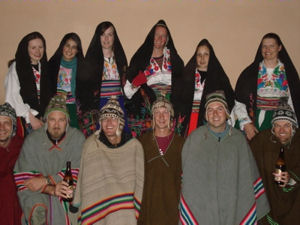 After a brief shopping trip to the local market to grab some souvenirs Charlotte, Ada and myself lunched at a great little cafe that was incredibly cheap and served up the most massive steaks. That afternoon we all went to see Sillustani, another set of ruins. These date back to way before the Incas and the only remnants of the civilisation are the funeral towers, used to house the rulers.
Due to the altitude the sky is particularly clear and the nearby lake was an amazing blue colour, as shown in the header of this website.
After a brief shopping trip to the local market to grab some souvenirs Charlotte, Ada and myself lunched at a great little cafe that was incredibly cheap and served up the most massive steaks. That afternoon we all went to see Sillustani, another set of ruins. These date back to way before the Incas and the only remnants of the civilisation are the funeral towers, used to house the rulers.
Due to the altitude the sky is particularly clear and the nearby lake was an amazing blue colour, as shown in the header of this website.That evening we had another farewell party and somehow commandeered the whole of a funky little club - then spent a good few hours dancing to cheesy and dancy numbers. The next day was another early start and I was again glad to be chauffeured as today we crossed the border into Bolivia, and it was market day.